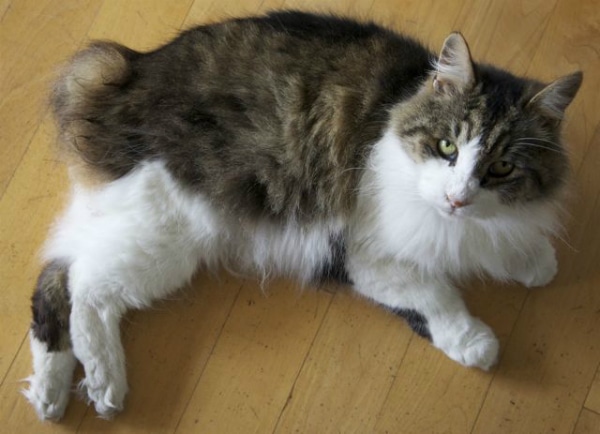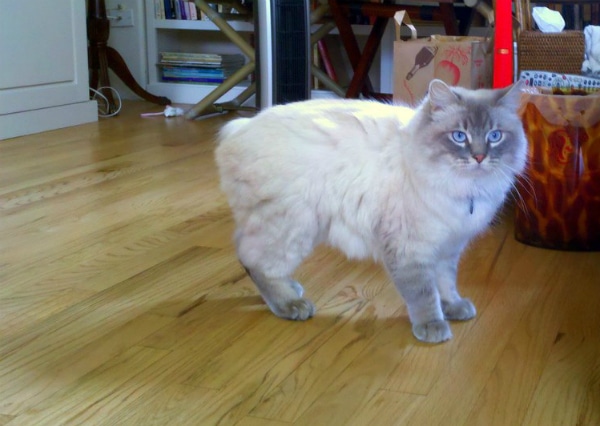One of the most defining features of a cat is her tail … unless she’s a Manx, that is. This breed’s unique appearance has spawned a crazy array of origin stories, but here’s the true scoop on how the Manx came to be.

Origins
It’s thought the Manx cat arose from a spontaneous mutation in the native cat population on the Isle of Man, an island located in the Irish Sea about halfway between England and Ireland. Because of the isolated population and the fact that the tailless gene is dominant — it only needs one copy of the gene to express itself — the mutation spread among the island’s feline population.
The first picture of a Manx cat dates back to the early 19th century, although verbal accounts of the breed’s existence can be found as far back as 1750. The Manx was one of the original breeds in the cat fancy and was being shown in the late 1800s. When the Cat Fanciers’ Association was founded in 1906, the Manx, along with the Siamese, Maine Coon and American Shorthair, was one of the first breeds ever to be shown.

Appearance
The Manx is a robust breed: rounded, muscular and double-coated. Because of the mutation that caused him to be tailless, his rear legs are much longer than his front ones, giving him an almost rabbit-like appearance and making him a very powerful jumper.
Manx cats come in all color patterns, although pointed, dilute and ticked-tabby coats are disqualifications from shows in the Cat Fanciers’ Association standard. The International Cat Association, however, allows all colors. Manxes can be short-haired or long-haired, although the long-haired variety is sometimes referred to as the Cymric.
Manxes’ tails can range in length from the rumpy (completely tailless) to the longy, which has a full tail, and several different tail lengths can be found in the same litter.

Health and longevity
The Manx is a generally robust breed, but the mutation that caused the taillessness can cause serious health problems when Manxes are not bred responsibly. One condition that appears in the breed is sacrocaudal dysgenesis, also known as “Manx syndrome,” in which the tailless gene causes the spine to be too short. This leads to damage to the spinal cord and the nerves leading from it and can result in walking problems, urinary tract defects, fecal incontinence, chronic constipation and megacolon.
Manxes also tend to be more prone than most cats to mast cell tumors and corneal dystrophy, a clouding of the eyes that can lead to blindness.
What it’s like to live with a Manx
The Manx is known as an outgoing, athletic and intelligent cat. Many Manxes like to play fetch, and they can be trained to do tricks. Your Manx will need to have plenty of high places from which to survey her domain. You’ll find that your Manx is a very people-oriented kitty who will bond strongly with you and your family, and if you have young children, she will enjoy their company too. She retains her strong prey drive from her roots as a working cat, so she’ll need plenty of opportunities to express that prey drive in appropriate ways.

Manx trivia bits
- The Manx is referred to as stubbin or kayt Manninagh in the Manx language.
- The Isle of Man has featured the Manx on its currency, coins and postage stamps.
- Koko, the famous sign-language-using gorilla, has had three Manx cats as companions. Their names were All Ball, Lipstick and Smokey.
Do you live with a Manx? What is it like to live with her? Please share your thoughts and Manx photos in the comments.
Read more on cat breeds:
- Meet the Tonkinese: The “Perma-Kitten” With a Heart of Gold
- Get to Know the Nebelung: The Cat of the Mists
- Get to Know the American Shorthair: One of America’s Original Cats
- Why Cat Breeds Like the Bengal, Savannah and Chausie Have No Business Being Banned
- Meet the Sphynx, the Official Cat Breed of National Nude Day
- Meet the Lykoi, Better Known as the Werewolf Cat
- In Honor of Colonel Meow: 6 Long-Haired Cat Breeds I Love
- A Grand Tour of Scottish Fold Kittens
Learn more about your cat with Catster:
- I’m Willing to Bet That Your Cat Hates Her Litter Box — Here’s Why
- Weird Cat Facts: 8 Reasons Your Cat Likes to Lick You
- Our Best Tips for Getting Your Cat to Let You Sleep
About JaneA Kelley: Punk-rock cat mom, science nerd, animal shelter volunteer and all-around geek with a passion for bad puns, intelligent conversation, and role-play adventure games. She gratefully and gracefully accepts her status as chief cat slave for her family of feline bloggers, who have been writing their award-winning cat advice blog, Paws and Effect, since 2003.







